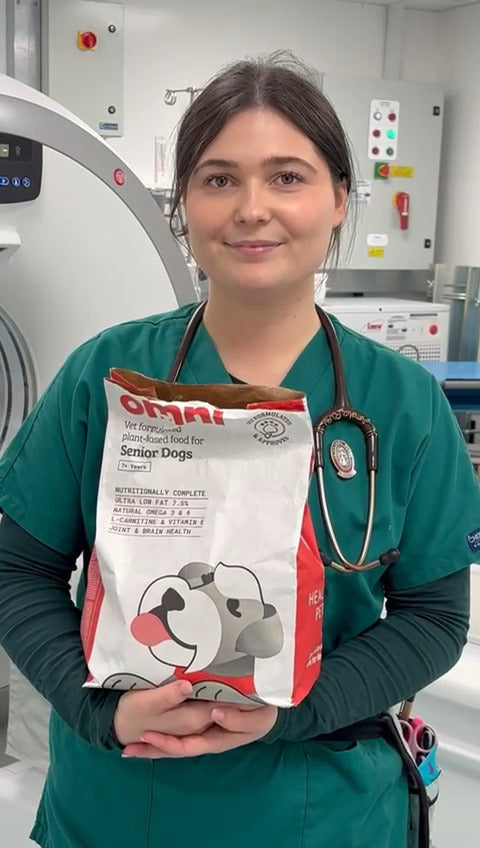Why Is My Dog Limping But Showing No Other Signs of Pain?

Rosie from Cambridgeshire has a dog called Edgar.
Edgar is a lurcher who, out of nowhere, developed a slight limp in his hind leg, meaning he couldn’t run as fast as he normally likes.
However, Rosie can’t find the source of Edgar’s woes - which led her to turn to us, knowing that Omni was staffed by vets with decades of clinical experience, to find the solution.
Dr Guy Sandelowsky MRCVS, Omni’s Chief Vet, decided to turn this into an article, as Rosie and Edgar aren’t the only ones experiencing the problem of the phantom limp.
Firstly, however, it is important to note that it can be difficult to recognise whether your dog is in pain or not because dogs simply don’t express pain in the same way as humans. Just because your dog is not showing signs of pain does not mean that they do not feel pain. Dogs often try to hide their pain in order to keep up with their humans, as in the wild an injured dog or wolf may be left behind.
Reasons Why Your Dog Might Be Limping
1. Your Dog May Have Arthritis
Arthritis is an incredibly common problem facing many dogs across the UK.
According to Davies Veterinary Specialists, up to 20% of dogs (around 1.3 million!) may be suffering from osteoarthritis at any given moment.
Especially for older dogs or dogs of particularly prone breeds (e.g., large or unnaturally-shaped dogs), arthritis is a real worry. So here’s how to spot it.
How to Spot if Your Dog Has Arthritis:
- Lower activity levels: Arthritis can cause pain and tiredness in dogs and that leads them to resort to sleeping more and being less active.
- Slower: Dogs with arthritis are unable to move their joints as quickly as they used to, so they often slow down significantly in their movement. This may not just affect the limb on which they are limping but can affect all of their joints in some way or other.
- Change in mobility, e.g., not jumping on the counter anymore, or struggling to get into bed.
- Lameness: What Rosie noticed in Edgar, above, could be described as ‘lameness’, as Edgar was dragging one of his hind legs behind him and seemed unable to put any weight on it. This is a common symptom of arthritis.
How to Help Your Dog With Arthritis:
- Seek veterinary advice: Arthritis can be managed and there are some treatments available, but make sure you contact your vet so that they can monitor the situation over time.
- Shorter exercise periods on soft ground: Unfortunately dogs with arthritis simply aren’t able to walk as long as they used to, so shorter walks are essential. In addition, hard surfaces like pavements or tarmac can cause too much impact for their long-term joint health.
- Hydrotherapy or physiotherapy: Most vets do not offer these services, but there are many qualified dog hydrotherapists and physiotherapists who may be able to help your dog. We recommend checking for qualified professionals in your local area and reading their reviews.
2. Soft Tissue Injuries Could Cause Limping
A ‘soft tissue injury’ is a broad term and refers to any part of your dog’s body except for their bones. Soft tissues include muscles, tendons and ligaments, all of which are likely to get damaged during strenuous exercise like running, or even just by bending or stretching in an awkward manner.
These issues are particularly common in some dogs that have been bred into unnatural body forms, as well as in older dogs who (like older people) may have weaker tendons and ligaments that connect their muscles to other muscles and bones.
If some of this soft tissue becomes damaged or inflamed, it can cause pain to your dog. This discomfort is translated into a limp when they try to move around in order to try and avoid the injured tissue.
Key Signs of Soft Tissue Injuries in Dogs:
- Lameness, or not being able to use a limb properly, resulting in a limp.
- Changes to mobility, such as not being able to jump up onto or down from the sofa or a bed.
- Yelping or vocalisation.
What You Should Do:
- Seek veterinary advice: If your dog is showing the symptoms of soft tissue injury, it is important that you seek veterinary advice as soon as you can.
- Rest. Your dog should not walk as much, if at all, on an injury to a muscle, tendon, or ligament.
3. ‘Foreign Bodies’ Can Cause Limps
“Foreign Bodies” are vet-speak for objects like thorns, twigs, or stones that can get lodged typically in your dog’s paw, between toes, underneath nails, or elsewhere.
These can cause discomfort, especially if they are rubbing against or penetrating the skin, but they can also be relatively painless and simply throw your dog off kilter slightly as long as they are in there, much like having a stone in your shoe.
Key Signs of Foreign Bodies in Your Dog’s Paws:
These are very similar to the signs of soft tissue injury, above:
- Lameness, or not being able to use a limb properly, resulting in a limp.
- Changes to mobility, such as not being able to jump up onto or down from the sofa or a bed.
- Yelping or vocalisation.
- Excessive licking or chewing at one specific area
However, make sure to go through each of your dog’s paws and feel around for anything that may be causing pain or discomfort. You may not be able to feel a tiny foreign body easily, but you may see by pressing gently, if it is safe to do so, whether your dog winces and tries to pull their paw out of your hand.
What You Should Do If Your Dog Has a Foreign Body Irritant:
- If you cannot remove the foreign body safely yourself, you should seek veterinary advice for further assessment, removal, and pain management.
Summary of Common Reasons for Limping:
- Arthritis: Especially common in older dogs, arthritis can usually be treated effectively with veterinary intervention, especially in the early stages.
- Soft tissue injuries: Damage especially to muscles, tendons and ligaments can cause your dog to limp, but the problem is often invisible from the outside.
- Foreign bodies like thorns or stones getting lodged in awkward places in your dog’s paws can cause limping.
- Usually, dogs who are limping are in pain, even if they don’t show you that. Humans show signs of pain far more readily than dogs
When to Contact a Vet
You should contact a vet if:
- Your dog is constantly limping with no obvious cause.
- Your dog is bleeding.
- Your dog keeps yelping.
- Your dog is lethargic.
If you’re worried about your dog’s health, it’s always best to get professional advice. Book a free consultation with our vet team at Omni for expert guidance on what could be causing your dog’s limping and how to manage it.
Thoughts from Dr Guy MRCVS
As dog lovers and guardians, it’s natural to worry about our furry friends, especially when they display abnormal symptoms that can’t be easily explained. That’s why, when I founded Omni, I knew that I wanted to keep vet consultation free and accessible at the heart of the business.
If you’re understandably worried about your dog, but you don’t think you need to take them to the vets urgently, I highly recommend getting some friendly, professional advice from one of our team.
Explore some of the frequently asked questions in our Ask a Vet series
Got a question for the Ask a Vet team?
Submit your question via email to woof@omni.pet. We’ll get back to you as soon as we can, and, if suitable, post the response here to help others, too!
Disclaimer: Our Video Vet Consultation service is limited because we are unable to perform a full physical examination of your pet. Our vets have no responsibility for the examination or other medical services provided during the Consultation.
Please note that our Video Vet Consultations do not replace traditional veterinary care, but can provide additional support. Based on the information you have provided and the symptoms you have described, the Vet will give you advice and an ongoing plan. Without a physical examination, we cannot provide a definitive diagnosis. If you are worried that your dog's condition is worsening, or you need additional support, please schedule another consultation, or see your registered vet.







 85 Great Portland Street, 1st Floor, London, W1W 7LT United Kingdom
85 Great Portland Street, 1st Floor, London, W1W 7LT United Kingdom